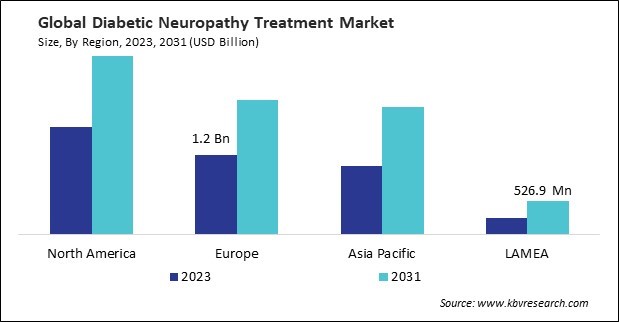According to a new report, published by KBV research, The Global Diabetic Neuropathy Treatment Market size is expected to reach $7.4 billion by 2031, rising at a market growth of 7.3% CAGR during the forecast period.
The Retail Pharmacies segment is anticipating a CAGR of 7.7% during (2024 - 2031). Retail pharmacies offer a wide range of medications for diabetic neuropathy, including pain relievers, antidepressants, anticonvulsants, and other medications commonly used to manage symptoms of the condition. These pharmacies also provide over-the-counter medications and supplies that can be helpful for individuals with diabetic neuropathy, such as foot care products and vitamins.

The Non-Steroidal Anti-inflammatory Drugs (NSAIDs) segment is leading the Global Diabetic Neuropathy Treatment Market by Drug Class in 2023; thereby, achieving a market value of $2.8 billion by 2031. NSAIDs include a range of medications, both prescription and over the counter, used to relieve pain and inflammation associated with diabetic neuropathy. Common NSAIDs include ibuprofen, naproxen, and aspirin. NSAIDs function by impeding the synthesis of prostaglandins, which are endogenous lipid compounds implicated in the pathogenesis of inflammation and pain.
The Proximal Neuropathy segment is registering a CAGR of 8.7% during (2024 - 2031). Diabetic proximal neuropathy, alternatively referred to as diabetic amyotrophy or diabetic lumbosacral radiculoplexus neuropathy, impacts the nerve supply to the legs, hips, thighs, or buttocks. It is characterized by severe pain, weakness, and muscle atrophy, often on one side of the body. The demand for proximal neuropathy treatments is driven by the need for effective therapies to manage the debilitating symptoms of this condition.
Full Report: https://www.kbvresearch.com/diabetic-neuropathy-treatment-market/
The North America region dominated the Global Diabetic Neuropathy Treatment Market by Region in 2023, and would continue to be a dominant market till 2031; thereby, achieving a market value of $2.8 billion by 2031. The Europe region is experiencing a CAGR of 6.9% during (2024 - 2031). Additionally, The Asia Pacific region would exhibit a CAGR of 8.2% during (2024 - 2031).
By Distribution Channel
By Drug Class
By Disorder Type
By Geography
 Unique Offerings
Unique Offerings